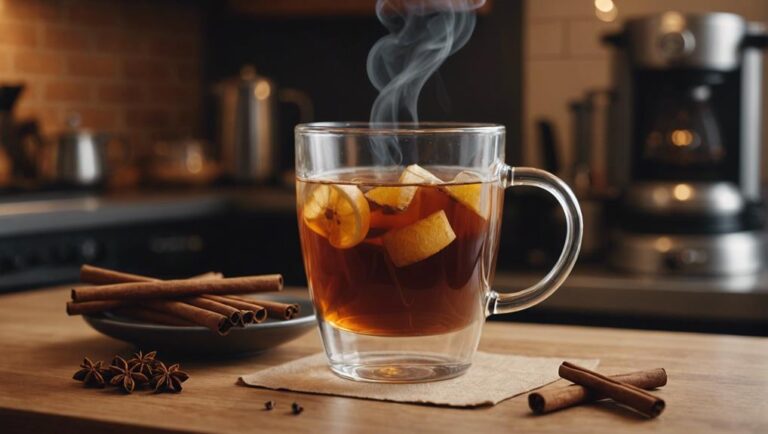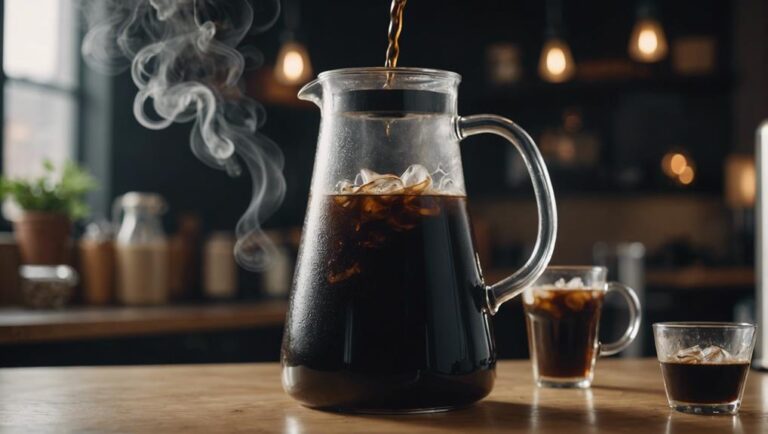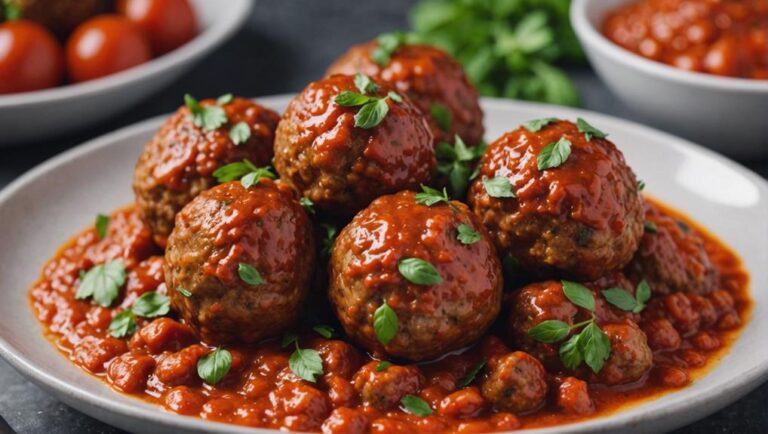Sous Vide Asian Beef and Broccoli
Step into a world of flavor fusion with tender sous vide-cooked Asian beef and crispy broccoli. Immerse yourself in the succulent textures and vibrant tastes that come together perfectly in each delectable bite. The marriage of juicy beef and fresh broccoli creates a culinary experience that is truly exquisite. Discover the art of combining precision cooking with rich flavors for a dish that will tantalize your taste buds and leave you craving more. Explore the intricate balance of ingredients and techniques that make this sous vide creation a standout in the domain of Asian-inspired cuisine. Open up a world of culinary delight.
What You Will Learn Here
- Sous vide cooking ensures tender beef and perfectly cooked broccoli.
- Infuse Asian flavors with soy sauce, ginger, and garlic for depth.
- Precise temperature control enhances flavors and textures.
- Searing post sous vide adds a caramelized crust for contrast.
- Experiment with additional ingredients like honey or sesame seeds for variety.
Historical Origins of Sous Vide

Let's trace the roots of sous vide cooking, exploring its origins and the journey of this technique through time. Understanding how sous vide has evolved can provide valuable insights into its widespread use in modern culinary practices.
Origins of Sous Vide
The origins of sous vide can be traced back to France in the 1970s, where chefs and food scientists began experimenting with this precise cooking technique. Initially, sous vide was rooted in traditional methods of food preservation, but it soon evolved into a culinary game-changer.
Sous vide innovations have been influenced by cultural practices from around the world, blending modern applications with age-old cooking traditions. This cooking method revolutionized how chefs approached precision and consistency in their dishes. By vacuum-sealing ingredients and cooking them in a precisely controlled water bath, sous vide became synonymous with elevating flavors and textures to new heights.
The journey from its humble beginnings to its current status as a staple technique in professional kitchens worldwide showcases the ingenuity and adaptability of culinary practices.
Evolution of Technique
As sous vide gained traction for its precision and flavor-enhancing capabilities, its historical origins reveal a fascinating evolution of culinary technique rooted in experimentation and innovation.
The modern innovations in sous vide cooking have their foundations in the early 1970s when French and American chefs began exploring the concept of cooking vacuum-sealed foods at precise temperatures for extended periods. This marked a significant shift in culinary approach, where technique advancements focused on achieving consistent results and enhancing flavors through controlled cooking environments.
Over the years, sous vide has evolved from a niche cooking method to a mainstream culinary technique embraced by chefs worldwide. The continuous refinements in equipment, temperature control, and cooking times have revolutionized how dishes are prepared, setting new standards for precision and excellence in the kitchen.
Culinary Impact Today
Rooted in a rich history of culinary experimentation and innovation, the modern impact of sous vide cooking techniques continues to shape contemporary gastronomy. The evolution of modern techniques in sous vide has revolutionized the way chefs approach cooking, allowing for precise temperature control and enhanced flavors.
Cultural influences have also played a significant role in the development of sous vide, with chefs incorporating diverse ingredients and flavors from around the world. This fusion of traditional cooking methods with modern technology has resulted in a culinary renaissance, where chefs can push the boundaries of flavor and texture.
As a result, sous vide has become a staple in professional kitchens and home cooking alike, showcasing the endless possibilities that this innovative technique offers to the culinary world.
Key Ingredients for Flavor

To enhance the robust flavors of the dish, consider incorporating a blend of aromatic spices and umami-rich ingredients. Achieving the perfect balance of flavors in your sous vide Asian beef and broccoli requires a thoughtful selection of key components. Here are three essential ingredients to take your dish to the next level:
- Soy Sauce: This staple ingredient not only adds a salty kick but also contributes a deep umami flavor that complements the beef and broccoli harmoniously.
- Ginger: Fresh ginger brings a zesty and slightly spicy note to the dish, elevating the overall taste profile with its aromatic essence.
- Garlic: A fundamental element in Asian cuisine, garlic provides a pungent and savory undertone that enhances the richness of the beef while infusing the broccoli with a delightful garlicky essence.
Succulent Sous Vide Creations
You're in for a treat as we explore the succulent world of sous vide creations.
Picture tender teriyaki beef stir-fry, ginger-garlic sous vide pork, and savory Korean short ribs tantalizing your taste buds.
These dishes promise a melt-in-your-mouth experience that will elevate your culinary skills to new heights.
Tender Teriyaki Beef Stir-Fry
A succulent creation in the world of sous vide cooking is the Tender Teriyaki Beef Stir-Fry, promising a delightful fusion of flavors and textures. This dish combines tender beef marinated in a savory teriyaki sauce, cooked to perfection using the sous vide method. Here's why this dish stands out:
- Tender Perfection: The sous vide technique guarantees the beef is cooked precisely to your desired level of doneness, resulting in melt-in-your-mouth deliciousness.
- Flavor Infusion: The beef marinade permeates the meat thoroughly during the sous vide process, infusing every bite with rich teriyaki taste.
- Quick Cooking: Despite its gourmet taste, this dish is quick to prepare once the beef is sous vide cooked, making it a convenient yet impressive meal option.
Ginger-Garlic Sous Vide Pork
Savor the succulent essence of ginger-garlic infused into perfectly cooked pork with this exquisite sous vide creation. The ginger garlic flavor penetrates the meat, creating a harmonious blend of aromas and tastes. Here's what makes this dish stand out:
- Enhanced Flavors: Sous vide techniques guarantee that the pork absorbs all the ginger and garlic flavors, resulting in a depth of taste that traditional cooking methods struggle to achieve.
- Tender Texture: The controlled low-temperature cooking of sous vide keeps the pork juicy and tender, giving you a melt-in-your-mouth experience.
- Consistent Results: With sous vide precision, each bite of pork is consistently cooked to perfection, ensuring a delightful dining experience every time.
Savory Korean Short Ribs
As you explore the world of succulent sous vide creations, prepare to be mesmerized by the tantalizing flavors and tenderness of Savory Korean Short Ribs. These ribs are a perfect balance of sweet, savory, and umami notes that will transport your taste buds to the bustling streets of Seoul.
Here's what makes these Korean-inspired short ribs a must-try:
- Korean Flavors: Infused with a marinade of soy sauce, garlic, ginger, and brown sugar, these short ribs encapsulate the bold and complex flavors of Korean cuisine.
- Short Rib Techniques: Cooked low and slow in a sous vide bath, these ribs achieve a melt-in-your-mouth texture while retaining all the juices and flavors within the meat.
- Sensational Sear: Finish these succulent ribs with a quick sear to create a caramelized crust that locks in the Korean-inspired goodness.
Searing for Flavor
When searing your sous vide beef, you'll lock in juices and intensify flavors. The caramelization achieved through searing adds depth and richness to your dish.
Importance of Searing
To enhance the depth of flavors in your Sous Vide Asian Beef and Broccoli dish, searing the meat before cooking is essential for developing a rich taste profile.
Searing techniques play a vital role in flavor development by creating a caramelized crust on the surface of the meat. This process not only adds a visually appealing color but also imparts a complex combination of savory and umami notes that intensify the overall taste experience.
By searing the beef, you lock in moisture and enhance the Maillard reaction, which leads to a more robust and satisfying flavor profile.
The caramelization achieved through searing enhances the natural sweetness of the meat while providing a contrast to the tender, sous vide-cooked interior, resulting in a harmonious blend of textures and tastes.
Enhancing Caramelized Flavors
Enhance the depth of your Sous Vide Asian Beef and Broccoli dish by skillfully searing the meat, revealing a symphony of caramelized flavors that will elevate your culinary experience.
The key to achieving this culinary excellence lies in the meticulous use of flavorful marinades and precise caramelization techniques. Prior to searing, consider marinating your beef in a blend of soy sauce, garlic, and ginger to infuse it with rich, savory undertones.
When it comes to searing, make sure your pan is scorching hot before adding the meat, allowing for a beautiful Maillard reaction that caramelizes the surface, creating a contrast of textures that will leave your taste buds tingling.
Mastering these techniques will result in a dish that isn't only visually appealing but bursting with complex, irresistible flavors.
Maillard Reaction Benefits
Discover the full potential of your Sous Vide Asian Beef and Broccoli dish by delving into the benefits of the Maillard reaction through expert searing techniques.
The Maillard reaction is a complex chemical process that occurs when proteins and sugars are exposed to heat, resulting in the browning and flavor enhancement of your food. By understanding the science behind the Maillard reaction, you can enhance the taste profile of your dish to new heights.
Searing your beef after sous vide cooking not only creates a beautifully caramelized crust but also reveals a depth of flavors that can't be achieved through other culinary techniques. This precise application of heat not only adds visual appeal but also contributes significantly to the overall taste experience, making each bite more satisfying and memorable.
Final Thoughts
In conclusion, the intricate flavors of the tender beef paired with the crisp broccoli create a harmonious and satisfying dish that's sure to impress your taste buds. Reflecting on the culinary journey of preparing Sous Vide Asian Beef and Broccoli, you've delved into the world of precision cooking, discovering a new level of tenderness and flavor infusion. The Maillard reaction benefits have truly shone through, enhancing the depth of taste and creating a delightful sensory experience.
As you experiment further with this recipe, consider some exciting variations to elevate your dish. Try adding a touch of honey for a subtle sweetness, or a sprinkle of toasted sesame seeds for a nutty crunch. You could also explore using different cuts of beef or even substituting broccoli with other vegetables like snap peas or bok choy for a personalized twist.
Frequently Asked Questions
Can I Use Frozen Beef for This Recipe?
Yes, you can use frozen beef for this sous vide recipe. It's a great way to achieve tender results quickly. Just make sure it's properly thawed before cooking to guarantee even cooking and best flavor infusion.
Is Sous Vide Cooking Safe for Pregnant Women?
When you're pregnant, using sous vide techniques requires extra care. Follow safety precautions meticulously to guarantee your food reaches the recommended internal temperatures. Properly cooked sous vide meals are generally safe for pregnant women, but always consult your healthcare provider.
What Other Vegetables Pair Well With Beef in Sous Vide?
When it comes to beef sous vide, consider a sous vide vegetable medley. Explore flavor pairings with ingredients like bell peppers, mushrooms, or asparagus. These culinary combinations enhance your dish, offering a harmonious blend of textures and tastes.
Can I Marinate the Beef Before Sous Vide Cooking?
Yes, marinating beef before sous vide cooking is a great way to enhance flavor infusion. Different marinating techniques can elevate taste profiles. It helps tenderize the meat and adds depth to the dish. Experiment with various flavors for a unique culinary experience.
How Long Can I Store Leftover Sous Vide Beef in the Fridge?
You can store leftover sous vide beef in the fridge for up to 3-4 days. Maintaining proper refrigerator storage is essential for food safety. Plan creative leftover recipes and meal ideas to enjoy your sous vide beef while ensuring freshness.
Conclusion
Indulge in the tender, perfectly cooked beef and crisp broccoli of this sous vide Asian dish. The historical technique of sous vide guarantees maximum flavor and juiciness, while the key ingredients of soy sauce, garlic, and ginger add depth and complexity.
Searing the beef after cooking brings a delicious caramelization that elevates the dish even further. Treat yourself to a gourmet experience with this succulent and flavorful sous vide creation.











